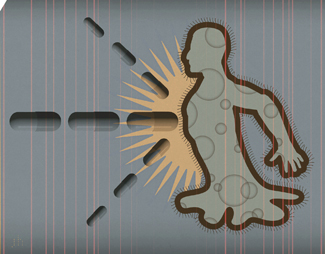A world awash in antibiotics breeds unstoppable microbes
John Hersey |
|
 |
|
By MITZI BAKER
In the pharmaceutical war against infection, microbes outsmart antibiotics at every turn, evolving defensive tactics against them.
For decades, this problem, called antibiotic resistance, has grown unabated, breeding chiefly in hospital settings.
Now a rise in antibiotic resistance originating outside hospitals has researchers worried. A commonly acquired hospital infection, Staphylococcus aureus, is increasingly cropping up in a painful and virulent form outside of hospitals, infecting otherwise healthy people. Stanford researchers are part of team that’s tracking the spread of this new infection. Among their findings: the bug is already common in the San Francisco Bay Area.
Staph lives on the skin and nasal passages of about one-third of healthy people. Normally the microbes cause little or no harm, at most forming pimples, boils or open skin infections that often heal without antibiotics. Sometimes, though, they can cause life-threatening blood, heart, bone and lung infections. Today, staph is a leading cause of the estimated 2 million infections in hospitals per year and the nearly 100,000 deaths that result.
Penicillin, which once worked against most staph strains, is now nearly useless. Methicillin and related drugs, developed to combat penicillin-resistant staph in the 1960s, are also increasingly ineffective against many staph infections.
As for new drugs, the pharmaceutical industry has little to offer. According to a report last year in Clinical Infectious Diseases, of 506 new drugs from big companies in the final stages of testing, only six are antibiotics.
Nationally, 60 percent of staph in hospitals is methicillin-resistant S. aureus — or MRSA. Stanford fares better, with a rate of 29 percent at Stanford Hospital and 18 percent at Lucile Packard Children’s Hospital, says Ellen Jo Baron, PhD, director of the medical center’s clinical microbiology and virology laboratories.
Baron and Debika Bhattacharya, MD, a research fellow in her lab, have teamed up with scientists at San Francisco General Hospital and San Mateo Medical Center to track the spread of MRSA within the community. From 2000 to 2002, they surveyed the genetics of drug-resistant staph found in their patients and categorized the infections by their source — hospital or community.
They found patients in all three hospitals carried MRSA infections originating from non-health-care settings. San Francisco General patients were the most likely to do so, with 38 percent of all MRSA infections surveyed there originating outside of the hospital.
With so many MRSA infections in the community, it’s important for physicians to be on the lookout, says Bhattacharya. They can’t treat them as standard infections because the usual drugs simply won’t work.
Prevention is really the best way to deal with a staph infection, says Baron. “Wash hands frequently and avoid sharing personal items like razors, towels and clothes,” she recommends.
Comments? Contact Stanford Medicine at

